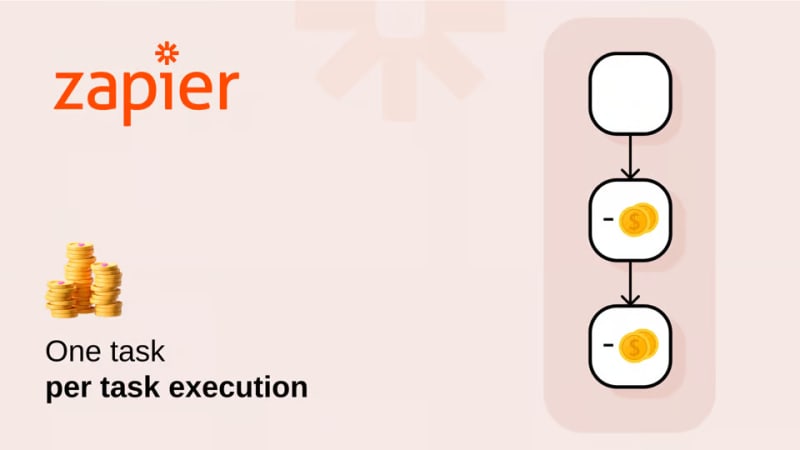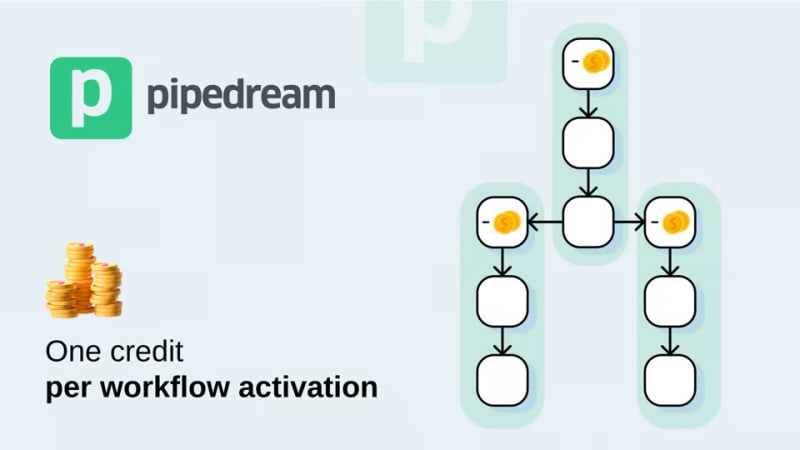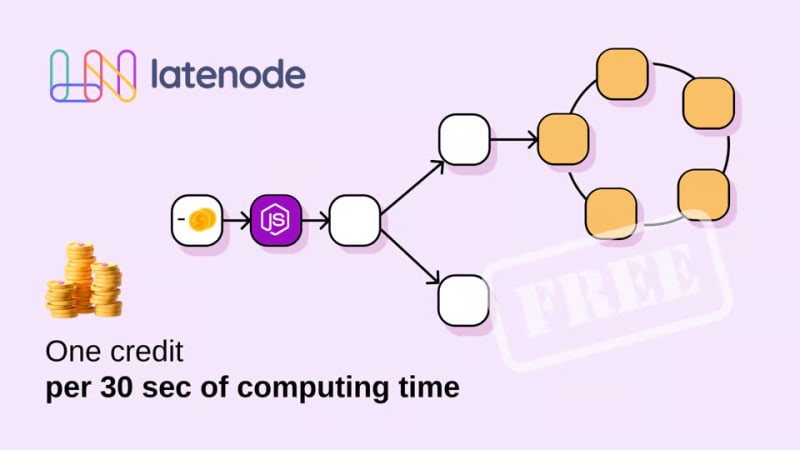Hello DEV community! It's Daniel from Latenode!
Three minutes of reading this material will uncover all the truth about the monetization systems your favorite low-code platforms use, so you become aware of why Latenode is 89.7 times cheaper than Zapier when it comes to automations with thousands of operations.
All images in this article are intended for illustrative purposes only. The '-💲' symbol depicted in the images denotes an internal fund debiting action within the platform and should not be interpreted as the cost of an individual operation or the overall scenario cost.
Zapier
Let’s start with Zapier, where the system is straightforward.
The execution of each action in your workflow consumes one task – credits you use on the platform for billing.
The more tasks in your workflow, the more you pay. And it doesn’t matter how much data you process or how many server resources you've used. Action executed? You’re billed!
However, Zapier’s team is proud of the fact that they don’t bill for the execution of the trigger – the starting node that runs your workflow. Well, appreciate it! Even so, you can’t add more than one trigger in your workflow. So in fact, you are protected from spending on just one extra task per automation. It's not a big deal.
Additionally, Zapier allows you to loop the chosen part of your workflow when the sequence of actions can be executed repeatedly.
And yes, you still need to pay with one task per each executed action within your loop.
Pipedream
Pipedream works differently – it uses credit instead of tasks, and Pipedream charges one credit per 30 seconds of compute time at 256 megabytes of memory per workflow execution.
Such a system looks more fair, because it’s not the same to get a single-line request from the server and to process complex data. The latter requires significantly more resources and time, and therefore, being charged based on the actual compute time and memory usage ensures that users only pay for the resources they consume.
But there is one thing... Pipedream doesn’t provide users with a loop like Zapier does, therefore often it’s not possible to complete your process within just one workflow you build on Pipedream. The only suggested workaround is by utilizing two different workflows.
- The first workflow is the fetching workflow. It grabs this array of records from Airtable, Google Sheets, Quickbooks, or some database or API.
- The second workflow is the processing workflow. It's responsible for processing a single record at a time, so that way you can use all of the pre-built actions Pipedream has to offer.
Why is this so? Because while Pipedream bills you for each 30 seconds of compute time, it also bills you for each run of your workflow. And apparently, it’s not very profitable to allow you to loop actions and execute everything within only one scenario.
The first low-code conspiracy revealed.
Make
When it comes to Make, everything becomes straightforward again – billing is based on the execution of each step.
Make is extremely great at building complex architecture, where you can build automations visually and connect everything to everything, not only each to next as Zapier does. The only differences are:
- What tasks are in Zapier, operations are on Make.
- What loops are in Zapier, iterators are on Make.
The only thing Make lacks (and this is intentional) is the ability to integrate custom code for working with data. Therefore, you can only build complex architectures using pre-built tools.
Does it affect the price? Of course! What you can get from only one JavaScript action on Pipedream requires the sequence of 3-5-7-9 different actions on Make.
Here is an example of a part of Make’s scenario that can be replaced with a single JavaScript module on Pipedream:
However, using Make would result in billing for four operations. Those of you who work with data understand how complex the logic for transformation and aggregation can be. Therefore, this example is somewhat simplified to illustrate the point clearly.
The second low-code conspiracy revealed.
Latenode
Speaking about Latenode, it has the same pricing model as Pipedream – one credit equals 30 seconds of computing time.
And while the initiation of your scenario also requires a credit, there is one huge difference – Latenode doesn’t force you to execute the maximum number of scenarios as Pipedream does if you need to iterate or loop data. So you’re free to run iterations within a single scenario run.
At the same time, the platform also doesn’t force you to the maximum number of actions in your scenario. Number of operations won’t be billed. That’s exactly why you also have full-code flexibility with the JavaScript module, that also includes work with NPM packages inside. Huge data processing is highly welcomed on Latenode.
Therefore, Latenode represents the most flexible, transparent, and fair platform in the context of pricing models. So users don’t think about anything else, but automations.
Does this mean you should abandon platforms you've been using for years? Not at all. However, in scenarios where you need to transform huge amounts of data on Make or iterate through thousands of JSON objects on Pipedream, consider making an HTTP request to Latenode. Transfer the data there for more cost-effective transformation in an environment suited for it. This way, you can avoid overpaying for your automations.
Reach out to Latenode’s low-code community on Discord and ask anything about automation on the platform itself.













Top comments (0)